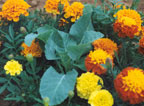
The term “companion planting” is not well known, but the
practice has been in place for thousands of years in various parts of the world.
Rather than planting row upon row of a certain type of vegetable, various
species are intermingled. For instance, taller plants that benefit from great
exposure to the sun can share space with low growing species that thrive in the
shade, resulting in higher yields. Companion planting simply means organizing a
garden in such a way that plants that benefit from each other’s growth are
placed close to each other.
There are several benefits and types of companion planting including trap
cropping and nurse cropping, the former occurring when a plant, attractive to
insects, is planted beside the main crop to lure insects away, the latter when
dense plants protect more susceptible species by creating shade or breaking the
harsh effects of the wind.
“Nurse crops such as oats have long been used to help
establish alfalfa by smothering the more competitive weeds,” writes Natural Life
magazine editor Wendy Priesnitz. There are also many plants that repel insects
and so protect neighbouring plants. Rye, as one example, is used as a mulch
around tomatoes because it releases a chemical that prevents weed germination.
Having a knowledge of Nature allows us to work with her. In companion planting,
this means optimal yields and optimal space usage, ensuring that all plants
thrive, not competing against each other, but supporting the growth and
proliferation of each other.
How much better for us and our world if we work with
Nature instead of against her.